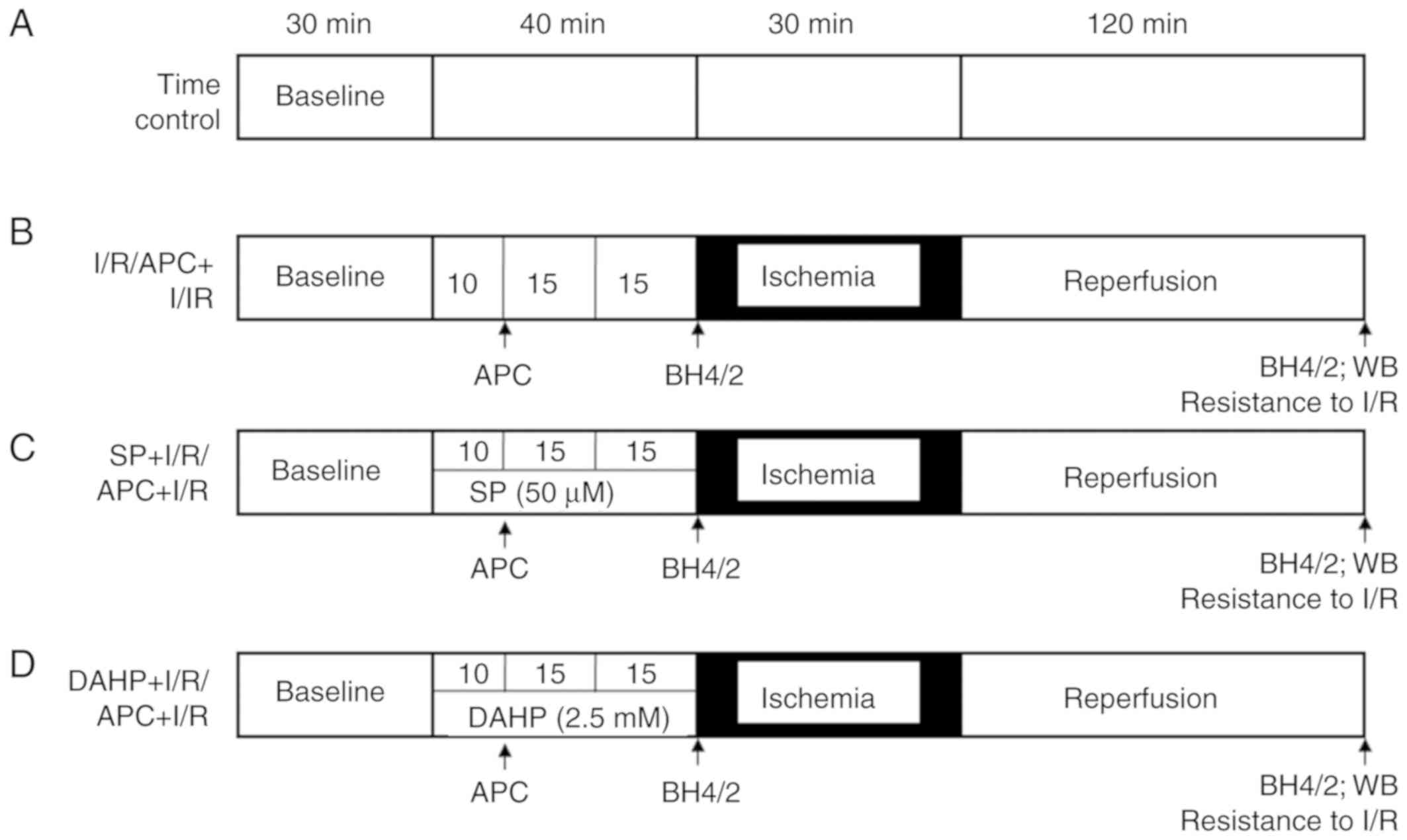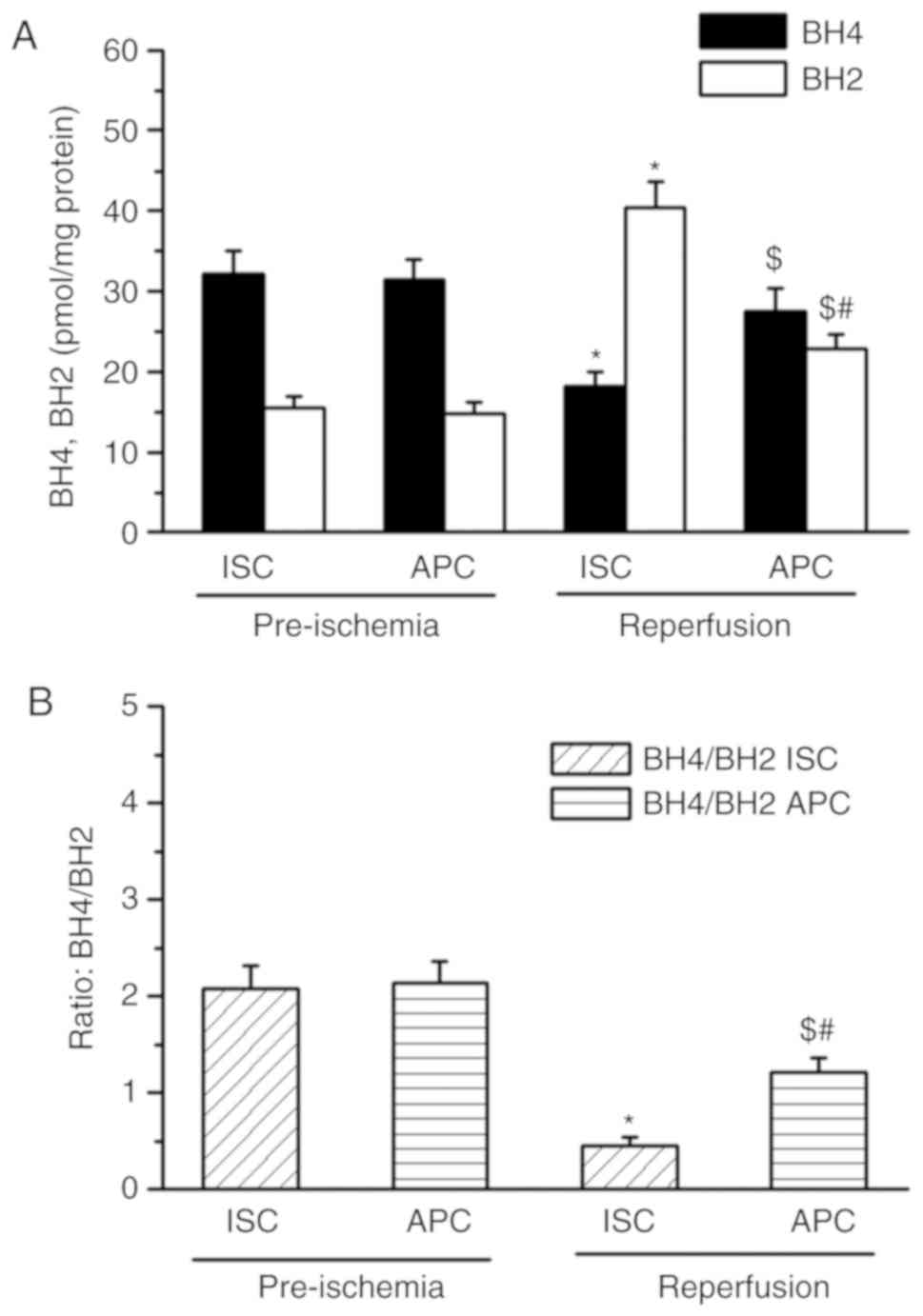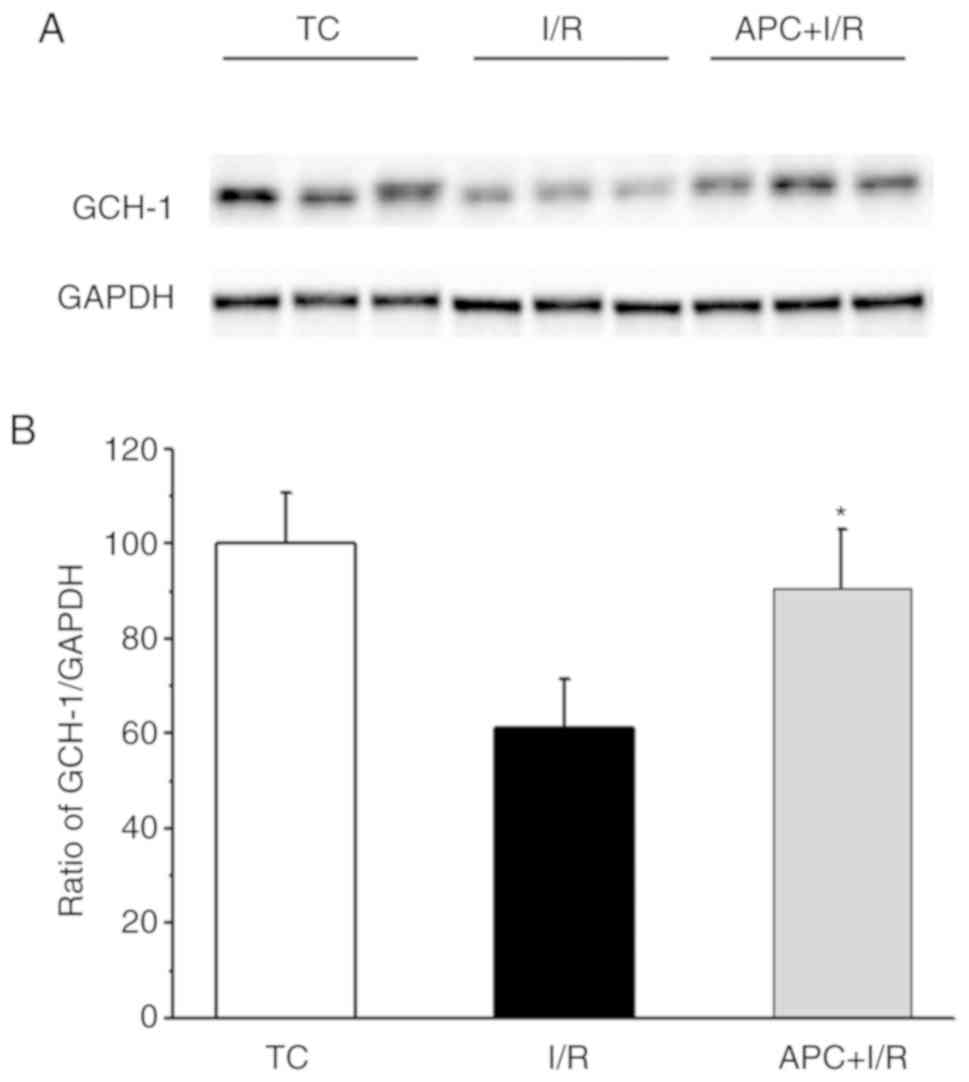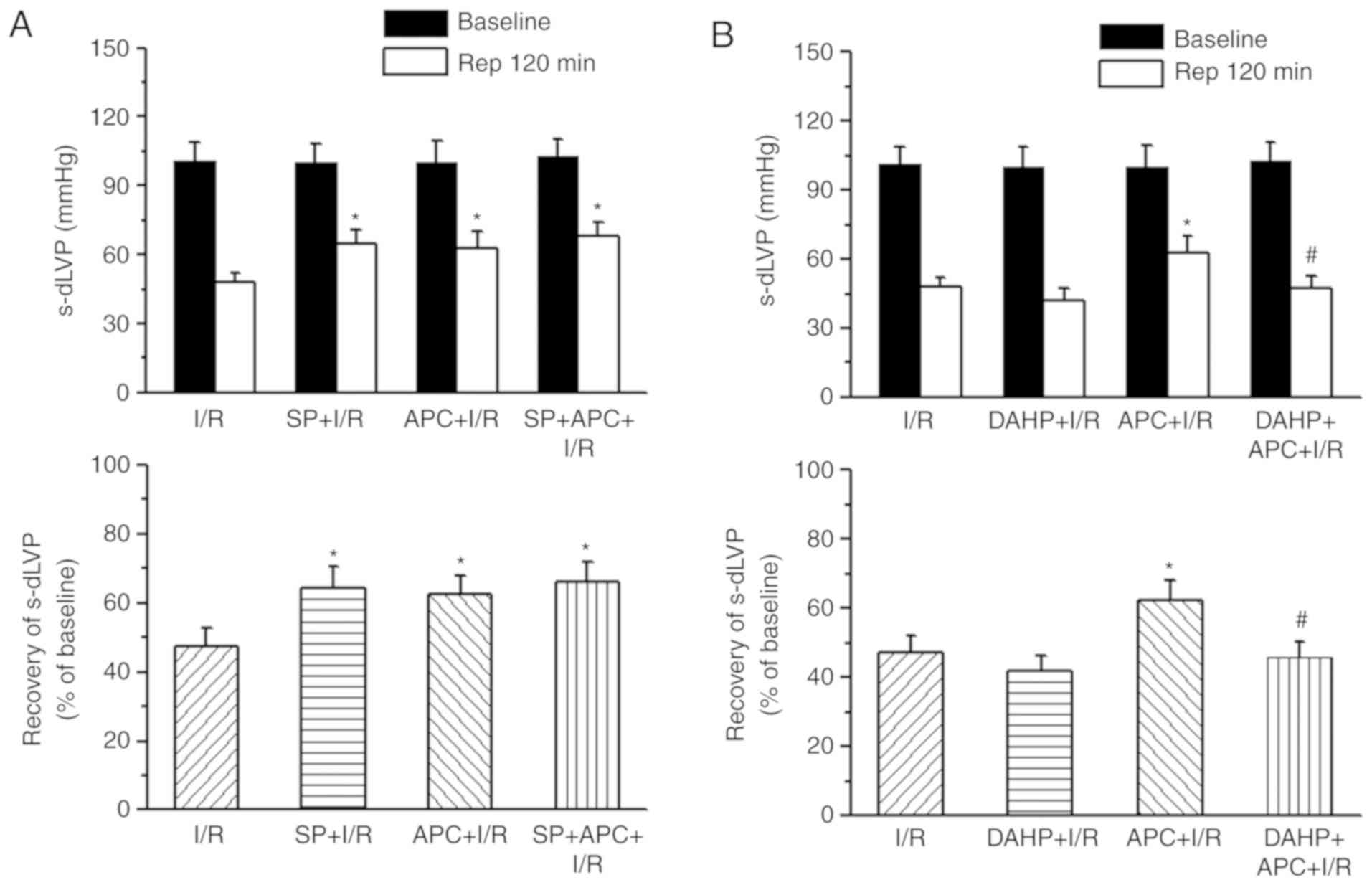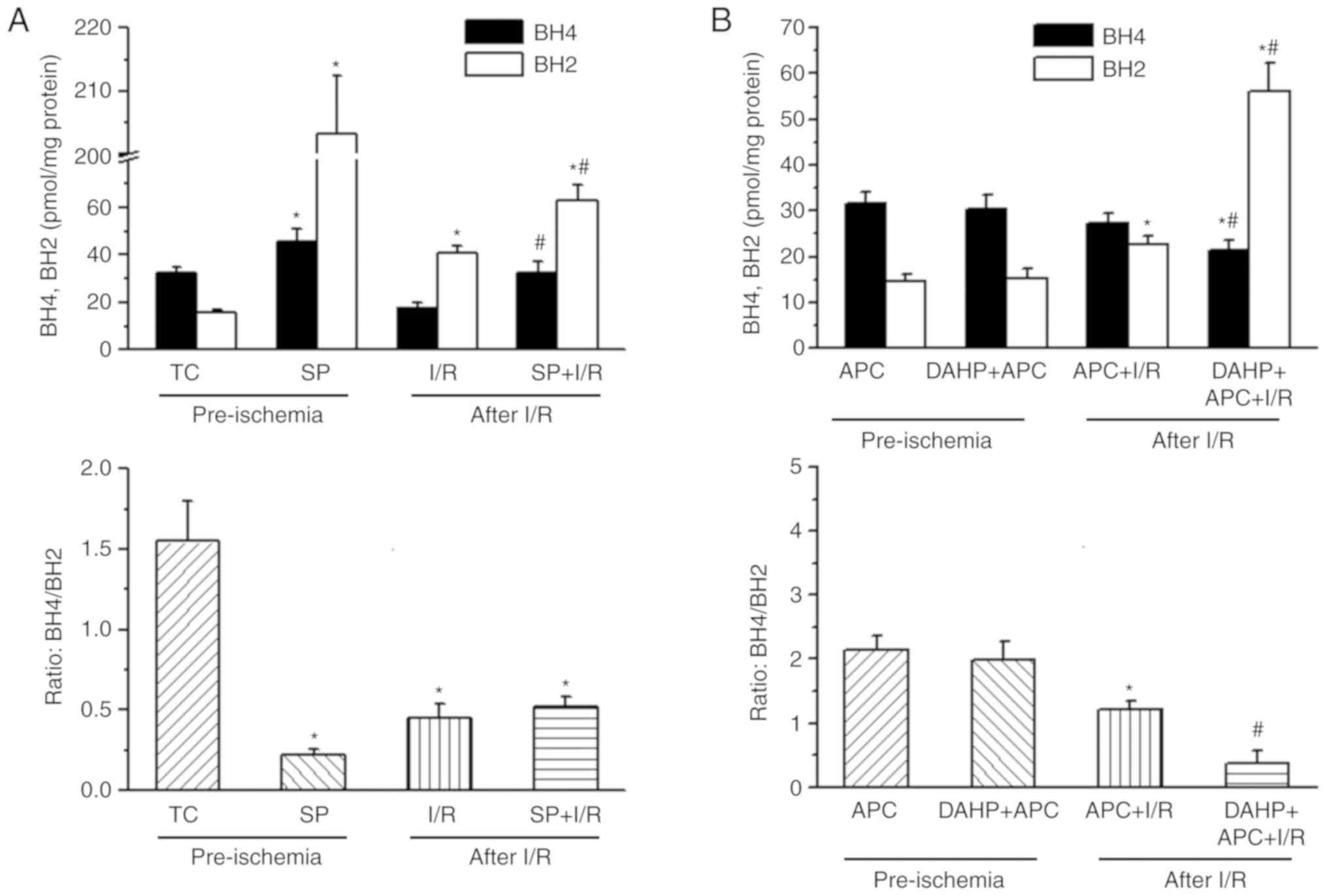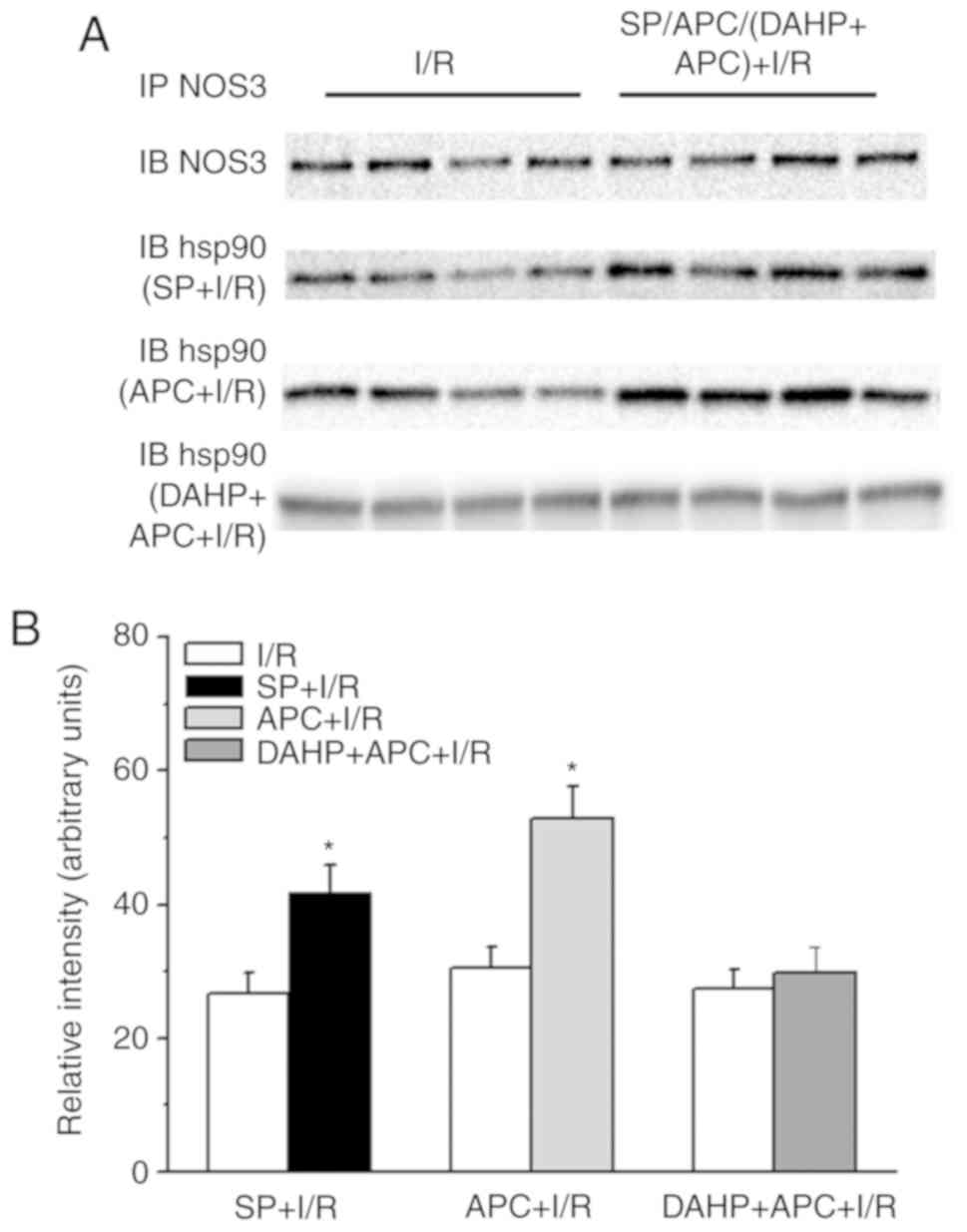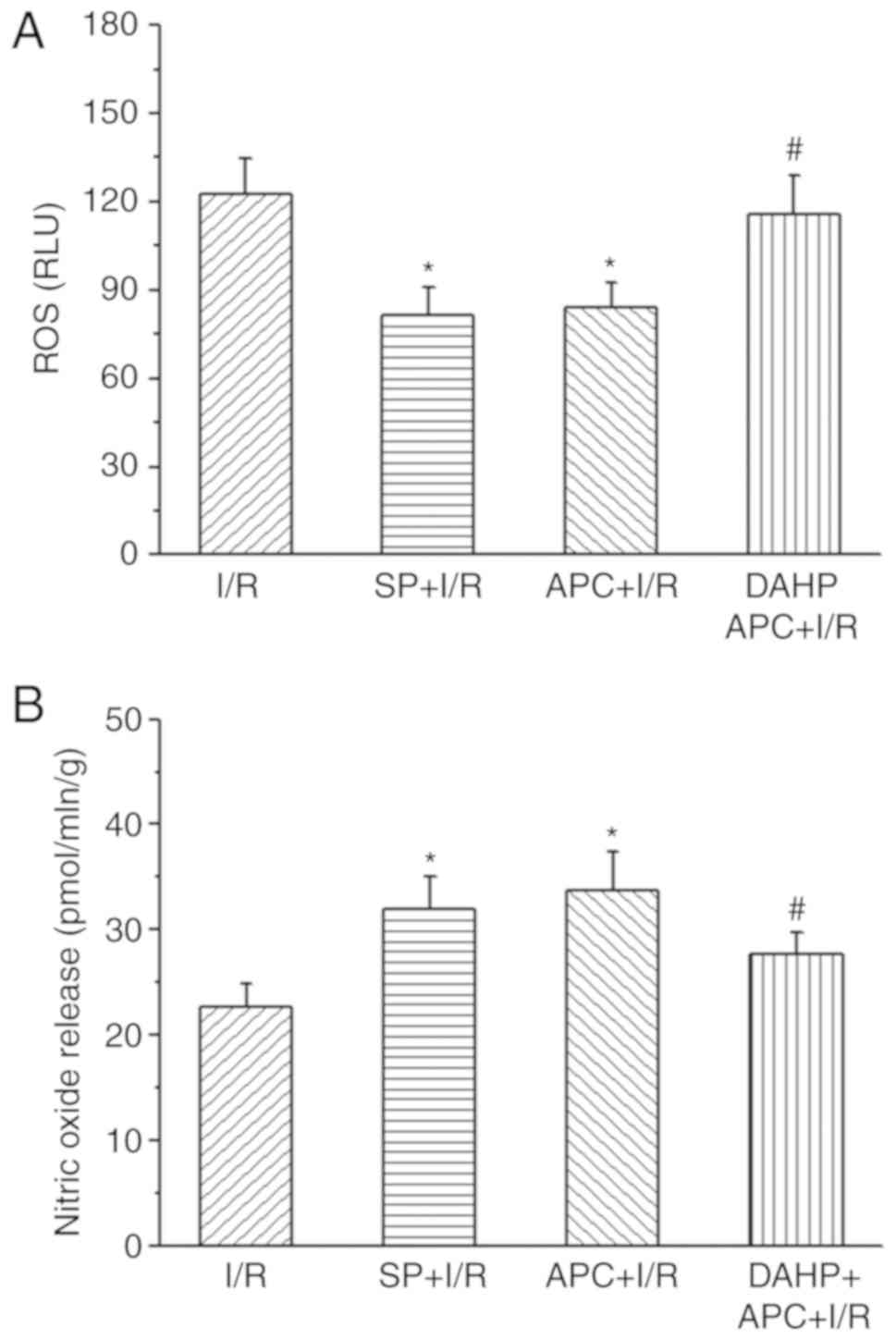NOS cofactor tetrahydrobiopterin contributes to anesthetic preconditioning induced myocardial protection in the isolated ex vivo rat heart
- Authors:
- Published online on: December 27, 2019 https://doi.org/10.3892/ijmm.2019.4445
- Pages: 615-622
Abstract
Introduction
Nitric oxide (NO) synthase, endothelial (NOS3)-derived NO is an important signaling molecule in the vascular system (1-3). The bioavailability of tetrahydrobiopterin (BH4) is critical for the catalytic activity of NOS3. The decreased effectiveness of BH4 leads to the decoupling of NOS3 and the production of reactive oxygen species (ROS) in endothelial cells (4,5). Decreased bioavailability of NO is an important factor in myocardial ischemia-reperfusion injury. The mechanism of NO reduction is associated with the lack of NOS substrate L-arginine and the cofactor BH4 leading to NOS decoupling (6).
Ischemia time-dependently decreases cardiac BH4 content and NOS3 activity, and increases NOS-derived superoxide anion (O2·-) production, which is considered to contribute to post-ischemic endothelial dysfunction and myocardial injury (6). The decrease in BH4 bioavailability is associated with the uncoupling of NOS3 activity and the production of NOS3-dependent O2·-. Increased resistance of the heart to ischemia is associated with the combination of heat shock protein 90 (HSP90) and NOS3 and subsequent increases in NO production (7). BH4 supplementation may restore endothelium-dependent coronary blood flow and decrease ischemia/reperfusion (I/R) injury in rat hearts (8,9), while inhibition of BH4 synthesis may increase I/R injury (10). These results suggest that myocardial BH4 bioavailability is an important factor in cardioprotection and supports the hypothesis that BH4 may be a novel therapeutic target for the treatment of I/R injury.
Increasing evidence indicates that NOS3-derived NO is a critical mediator of anesthetic preconditioning (APC) (10-13). Under hyperglycemic conditions, the cardioprotective effects of volatile anesthetics by BH4 and HSP90-regulated NOS3 activity was abrogated (14). However, the role of BH4 availability and the association of HSP90 with NOS3 in APC-mediated cardioprotection against I/R injury remain to be elucidated. The aims of the present study were to determine: i) Whether BH4 levels were different in I/R rat hearts with or without APC, and whether increasedBH4 levels contributed to resistance to I/R injury by APC; ii) whether BH4 supplementation with BH4 precursorsepiapterin (SP) and GTP cyclohydrolase I (GCH-1) inhibitor, 2,4-diamino-6-hydroxypyrimidine (DAHP) differentially modulated resistance to I/R injury in the control (I/R alone) and APC rat hearts and iii) whether BH4 supplementation alteredthe BH4:BH2ratio, consequently affecting NOS3 activity and the association of HSP90 with NOS3 in APC-induced cardioprotection.
Materials and methods
Animals
The present study was approved by the Institutional Animal Care and Use Committee of Nanjing University. Male Sprague-Dawley rats (250±50 g), aged 8-10 weeks, were purchased from the Animal Center of Suzhou University and were housed at 25°C with 60% humidity in a 12:12 h light: Dark cycle. All rats were housed in each cage and were allowed ad libitum access to food and water. All procedures performed on the rats used in the present study were in accordance with the National Institute Health Guide for the care and Use of Laboratory Animals.
Isolated heart preparation
The isolated heart preparation was performed as previously described (8,13,15). Briefly, rats were anesthetized with sodium pentobarbital (50 mg/kg i.p.) and decapitated when unresponsive to noxious stimulation (pinching the paw). The hearts were excised and perfused in the Langendorff mode at a perfusion pressure equivalent to 80 mmHg. Perfusate and bath temperatures were maintained at 37.2±0.1°C using a thermostatically controlled water circulator (Lauda E100; LAUDA). Left ventricular pressure (LVP) was measured isovolumetrically with a transducer connected to a thin saline-filled latex balloon inserted into the left ventricle through the mitral valve from an incision in the left atrium. The hearts were immersed in gassed physiological buffer solution at 37.2°C, and subjected to 30 min global ischemia followed by 120 min reperfusion. At the time points prior to ischemia or at the end of the experiments, the hearts were freeze-clamped and stored at −80°C until use in the BH4 and BH2 analyses by high performance liquid chromatography (HPLC) or western blot analysis.
Experimental protocols
Each experimental treatment phase lasted for 220 min. A total of 70 rats were used. The functional parameters were stabilized for 30 min; after that the hearts were randomly divided into 7 groups with 10 hearts in each group (Fig. 1). Untreated time controls (TC; without I/R) were perfused for 220 min without drugs or ischemia (timeline A). After 40 min of vehicle perfusion, the I/R group was subjected to 30 min of global ischemia and 120 min of reperfusion; the APC group was exposed to sevoflurane (3.5%; Abbott Pharmaceutical Co., Ltd.) for 15 min followed by a 15 min washout prior to the onset of ischemia (timeline B). In the SP + I/R or SP + APC groups, SP (50 µM; cat. no. 11.225; Schircks Laboratories) was administered for 40 min prior to the onset of ischemia (timeline C). In the DAHP + I/R or DAHP + APC groups, DAHP (2.5 mM; cat. no. D19206; Sigma-Aldrich, Merck KGaA) was administered for 40 min prior to the onset of ischemia (timeline D).
Measurement of BH4 and BH2
The contents of BH4 and BH2 in all cardiac homogenates were determined viaHPLC as previously described (8). BH4 and BH2 were quantified via HPLC with an electrochemical detector (ESA Biosciences CoulArray® system Model 542) using a Synergi Polar-RP column (Phenomenex) eluted with argon degassed 50 mM phosphate buffer (pH 2.6). Multi-channel colorimetric detection was set between 0 and 600 mV. A separate channel was set at -250 mV in order to verify the reversibility of BH4 oxidative peak detection. The peak areas were collected at 0 and 150 mV for BH4, and 280 and 365 mV for BH2, and the data were combined to obtain a calibration curve. Intracellular concentrations of BH4 and BH2 were calculated using authentic external BH4 and BH2 standards as previously described (8). Cellular BH4 and BH2 levels were then normalized to cell protein concentrations.
Western blot analysis
The western blot analysiswas performed as previously described (8). The protein content of the samples was determined using a BCA assay kit (P0010; Biyuntian Biotechnology Company) and was adjusted to the same concentration. After denaturation, 20 µg of each sample was dissolved in Laemmli sample buffer (cat. no. S3401; Sigma-Aldrich, Merck KGaA) and separated via SDS-PAGE (12% gel). Following transfer to nitrocellulose membranes, membranes were blocked with 5% non-fat milk in PBS and probed with primary antibodies at 4°C overnight and were incubated with HRP-Conjugated goat anti-rabbit secondary antibodies (1:10,000; cat. no. ab6721; Abcam) or HRP-conjugated goat anti-mouse secondary antibody (1:10,000; cat. no. sc-2031; Santa Cruz Biotechnology, Inc.) for 1 h at room temperature. The protein bands were visualized with a SuperSignal West Pico kit (cat. no. 34577; Pierce; Thermo Fisher Scientific, Inc.) and band densities were quantified using UN-SCAN-IT software (v.7.0; Silk Scientific, Inc.). Antibodies specific for GCH-1 (cat. no. ab26439, 1:2,000) and GAPDH (cat. no. ab9485, 1:2,500) used in the study were purchased from Abcam. The NOS3 (cat. no. PA3-031A; 1:1,000) and HSP90 (cat. no. MA1-10372; 1:1,000) antibodies were purchased from Invitrogen; Thermo Fisher Scientific, Inc.
Immunoprecipitation assay
Immunoprecipitation was performed as previously described (8). Hearts were homogenized in ice-cold lysis buffer and subjected to SDS-PAGE (12% gel). Proteins were detected using enhanced chemiluminescence detection reagents (cat. no. 34577; Pierce; Thermo Fisher Scientific, Inc.) for densitometric analysis with UN-SCAN-IT software.
Reactive oxygen species (ROS) detection
ROS (O2·-) production was detected using lucigenin-enhanced chemiluminescence as previously described (8). During the first minute of reperfusion, coronary effluent (1 ml) was collected and 500 µl was immediately transferred to a 1.5 ml vial, in which 5 µl of 500 µM lucigenin (cat. no. M8010; Sigma-Aldrich; Merck KGaA) was added. The final concentration was 5 µM. The vial was placed in a luminometer (Turner BioSystems, Inc.) in order to measure chemiluminescence for 5 min in the dark. A vial containing lucigenin was used to measure background luminescence, and this background value was subtracted from each sample value.The data of O2·- production was expressed as relative light units.
NO detection
In order to assess the effects of BH4 on NOS3 coupling, at 1 min of reperfusion, 1 ml coronary effluent was collected and NO concentrations were immediately determined using a NO electrode (World Precision Instruments). The values were normalized by heart wet weight and coronary flow rate as previously described (8). The NO electrodes were calibrated using NaNO2 (cat. no. 72586; Sigma-Aldrich; Merck KGaA) and KI (cat. no. 746428) +H2SO4 (cat. no. 339741) (both Sigma-Aldrich; Merck KGaA) following the manufacturer's protocol, to quantify the amount of NO produced.
Statistics analysis
The data are presented as the means ± standard error of the mean. In order to examine the overall differences between the groups, a two-way analysis of variance was used. The Student-Newman-Keuls multiple comparison post hoc test was used to differentiate within the groups. SPSS 19.0 (IBM Corp.) was used to perform the statistical analysis. P<0.05 was considered to indicate a statistically significant difference.
Results
BH4 and BH2 levels in APC and I/R rat hearts
As presented in Fig. 2, prior to ischemia, BH4 and BH2 levels were similar in both the I/R and APC + I/R groups (Fig. 2A). The BH2 level was significantly increased and the BH4 level decreased significantly in I/R hearts when compared with the pre-ischemia baseline values. Following I/R, the BH4 levels (27.4±1.9 vs. 18.1±1.9 pmols/mg protein) were increased and BH2 levels (22.7±1.8 vs. 40.3±3.2 pmols/mg protein) were decreased in the APC + I/R hearts when compared with the I/R hearts (P<0.05; n=10/group). The BH4:BH2 ratio in APC + I/R rat hearts was increased 2-fold compared with the I/R hearts (1.2±0.15 vs. 0.45±0.09).
GCH-1 protein levels
Fig. 3 presents the GCH-1 contents in TC, I/R and APC + I/R heart tissues. The GCH-1 expression level in APC + I/R hearts was increased by almost 30% compared with that in I/R hearts after I/R (n=3/group).
Supplementation of SP or DAHP on cardiac function
In order to determine whether BH4 contributed to the increased resistance to I/R injury in APC + I/R hearts compared with I/R hearts, the present study perfused isolated hearts with either a GCH-1 inhibitor (DAHP, 2.5 mM) or a BH4 donor (SP, 50 µM) for 40 min prior to ischemia with or without APC treatment. Left ventricular developed pressure (LVDP) was measured after 120 min reperfusion, using the percentage of pre-drug and pre-ischemic values. The recovery rate of LVDP following I/R in the APC + I/R hearts (62.7±7.6 mmHg and 62.6±5.2%) was significantly increased compared with that in the I/R group (48.0±4.0 mmHg and 47.4±5.1%) (P<0.01). SP treatment significantly improved the LVDP in I/R hearts (64.5±6.7 mmHg and 64.3±6.2%), but did not increase the recovery of LVDP in APC + I/R hearts (68±6.1 mmHg and 66±5.9%; Fig. 4A). DAHP treatment decreased the recovery of LVDP in APC hearts (41.7±5.1 mmHg and 45.7±4.6%) to the values observed in the I/R group hearts (Fig. 4B).
Supplementation of SP or DAHP on cardiac BH4 and BH2 levels
In order to observe the changes in BH4 and BH2 levels following SP or DAHP treatment in I/R or APC + I/R hearts, BH4 and BH2 levels were measured at 40 min after perfusion with SP or DAHP (pre-ischemia) or at 120 min reperfusion. Following SP treatment and prior to ischemia in the SP + I/R hearts, the levels of BH4 (45.4±5.4 vs. 32.1±2.9 pmols/mg protein; P<0.05) and BH2 (203±19 vs. 15.5±1.4 pmol/mg protein) were significantly increased when compared with the I/R hearts (P<0.001; Fig. 5A). At 120 min reperfusion, SP treatment increased BH4 levels significantly in the SP+IR group compared with the I/R group (32.4±4.5 vs. 18.1±1.9 pmol/mg protein; P<0.05). In the APC + I/R rat hearts, DAHP treatment prior to ischemia did not affect BH4 or BH2 levels (Fig. 5B). Following I/R, DAHP treatment significantly decreased BH4 levels (21.4±2.2 vs. 27.4±2.2 pmol/mg protein) and increased BH2 levels (56.1±6.2 vs. 22.7±1.8 pmol/mg protein) in the DAHP+APC hearts compared with the APC + I/R hearts (P<0.01). After 120 min reperfusion, the BH4:BH2 ratio was decreased in DAHP+APC + I/R hearts compared with the APC + I/R hearts (P<0.01).
Supplementation of SP or DAHP on the association of HSP90 and NOS3
In order to observe the effects of SP or APC on the interaction between HSP90 and NOS3 in I/R rat hearts, NOS3 was immunoprecipitated from the homogenates of I/R hearts following APC, SP or DAHP treatment and probed for NOS3 and HSP90 proteins (Fig. 6). The results demonstrated an increased association between HSP90 and NOS3 (>30%) in the SP+IR (IB hsp90-SR+I/R row) and APC + I/R hearts (IB hsp90-APC + I/R row) compared with the I/R group. However, this increase in association betweenHSP90 and NOS3 in the APC + I/R hearts was inhibited by treatment with DAHP (IB hsp90-DAHP+APC + I/R row).
NO and O2·- levels following I/R
The present study also measured •NO and O2·- production in I/R hearts following SP treatment or APC + I/R hearts following DAHP treatment (Fig. 7). The data revealed that the lucigenin chemiluminescence signal intensity, which represents O2·-(ROS) production, was significantly decreased in the SP + I/R and APC + I/R rat hearts, but increased in DAHP + APC + I/R rat hearts at the end of 120 min reperfusion. Following treatment with SP, the NO levels in the SP + I/R group was significantly increased compared with those in the I/R group, whereas DAHP treatment significantly decreased the NO levels in DAHP + APC + I/R hearts. APC treatment also significantly increased NO production in APC + I/R hearts compared with the I/R group.
Discussion
The maintenance of physiological levels of NO produced by NOS3 represents a key element for vascular function (16,17). As a pteridine cofactor, BH4 is an important regulator of NOS3 function, as BH4 is required to maintain enzymatic coupling of L-arginine oxidation, to produce NO (18,19). The present study assessed the role of BH4 and the BH4 biosynthetic precursor, SP, in the mechanisms underlying resistance to I/R injury in I/R hearts with or without APC. The results revealed that: i) BH4 levels were significantly increased and BH2 levels were significantly decreased in APC + I/R hearts compared with the I/R group hearts. The BH4:BH2 ratio in the APC-treated hearts was increased 2-fold compared with that in the I/R group hearts. The recovery of cardiac function in the APC-treated hearts was consistent with the alterations of BH4 and BH2 levels, and the BH4:BH2 ratio; ii) SP supplementation increased the resistance to I/R injury in the I/R group, and GCH-1 inhibition decreased APC-induced cardiac function recovery; iii) SP supplementation increased the association between HSP90 and NOS3; while GCH-1 inhibition by DAHP decreased this association; iv) ROS (O2·-) production decreased and NO levels were increased significantly following SP treatment in the I/R group, and ROS production increased and NO levels decreased following DAHP treatment in APC + I/R hearts at the initial time of reperfusion. The results of the present study indicate that BH4 and the ongoing synthesis of BH4 participated in the susceptibility to I/R injury in the APC + I/R and I/R group hearts. APC-induced resistance to I/R injury was mediated by the NOS3 cofactor BH4 and the elevation of HSP90-NOS3 association.
In I/R-injured hearts, lowering BH4 levels may be an important cellular defect involving endothelial and cardiomyocyte dysfunction (6,20). The role of BH4 in NOS activity is important in cardioprotection. The decrease in BH4 levels not only prevents NOS3 from generating NO, but also causes NOS3 'uncoupling', resulting in NOS3 generating O2·- instead of NO (21). BH4 deficiency due to decreased BH4 biosynthesis or BH4 oxidation to BH2 (less catalytic activity) is known to be one of the causes of I/R injury (8). The results of the present study are consistent with these data, in that BH4 level and the BH4:BH2 ratio in APC-treated hearts were significantly increased compared with that in the I/R group, confirming that BH4 serves a crucial role in I/R injury. The importance of the BH4:BH2 ratio in determining whether BH4 and BH2 bind to NOS3 has been revealed in recent studies. As the affinity of BH4 and BH2 to NOS3 is equal, BH4 in NOS3 can be rapidly and efficiently replaced by BH2, resulting in the uncoupling of NOS3 activity, and decreased NO synthesis (2,22). APC treatment demonstrated increased BH4 and decreased BH2 levels following I/R. Therefore, in addition to decreased BH4 levels, the BH4:BH2 ratio was significantly decreased in I/R group hearts compared with that in the APC + I/R hearts, which may also lead to NOS3 uncoupling, an increase in O2·- production and decreased cardiac function recovery.
Increasing the availability of BH4 by modulating GCH-1 has been recognized as a novel strategy for protecting the heart during post-infarction remodeling, dilated myopathic remodeling and cardiac hypertrophy (23). Certain studies have demonstrated that the treatment of exogenous BH4 or BH4 precursor SP may promote NO production and NOS-dependent coronary flow recovery following isch-emia (6,24). SP supplementation enhanced the resistance to I/R injury in the I/R group. Notably, the results of the present study demonstrated that SP did not alter the APC-induced cardioprotection observed, suggesting that the cardiac protection induced by APC had reached its maximum effect. Resistance to I/R injury by APC was abrogated to levels that were not significantly different from the I/R group when GCH-1 was inhibited with DAHP. In addition, the GCH-1 inhibitor DAHP did not affect the functional recovery of the I/R group, but SP supplementation increased the functional recovery to a level comparable with that of APC-treated hearts. This association provides evidence that BH4 levels are associated with APC-induced cardioprotection.
The present study hypothesized that BH4 serves a crucial role in NOS3 activity, NO generation, potentially with O2·- formation as suggested by the lucigenin chemiluminescence assay, and vascular reactivity during I/R. The increased lucigenin chemiluminescence signal intensity, representing the level of O2·- released, or net emission, from I/R rat hearts was significantly attenuated by SP and APC, but increased in the DAHP +APC +I/R group. Furthermore, there was a greater lucigenin chemiluminescence signal intensity from I/R alone hearts. NO release was increased in I/R alone hearts through SP supplementation, while DAHP significantly decreased NO production in APC + I/R hearts. These data confirmed that BH4 levels were associated with NOS-dependent NO production, and decreased O2·- generation.
A previous study has demonstrated that APC enhanced GTPCH-1 and NOS3 expression levels, and promoted the production of NO in the myocardium following reperfusion (11). In C57BL/6 mice hearts, the rate of LV pressure rise, BH4 level, Ca2+ handling proteins and SR Ca2+ release were decreased following I/R, which was associated with GCH1 degradation (25). In the coronary arteries of rats with heart failure, both NOS3 and GCH1 protein expression levels increased concomitantly with the decrease in ROS generation, increase of NO bioavailability and NOS3 coupling (26). A high level of GCH-1 expression in APC + I/R rats was also observed in the present study, indicating that increased GCH-1 expression is involved in volatile anesthetic-induced cardio-protection.
Previous studies have demonstrated that an increased association between HSP90 and NOS3 contributed to cardio-protection against I/R by increasing NO generation and decreasing O2·- production (7,27). The results of the present study also demonstrated that SP supplementation increased the association between HSP90 and NOS3, while DAHP supplementation decreased this association in APC + I/R hearts, consistent with the results of a previous study (8). These data demonstrated that BH4 improved NOS3 activity and function, which is an important mechanism underlying APC-induced cardioprotection.
In summary, the present study demonstrated that BH4 and GCH-1 differentially modulated APC-induced cardioprotection against I/R injury. BH4 biosynthesis, regulated by GCH-1, served a key role in the enhancement of NO generation during APC, and NO, in turn, conferred a cardioprotective effect. Furthermore, the differences in the BH4:BH2 ratio, which were associated with NOS3 coupling state and the increase in heart BH4 oxidation, conferred a cardioprotective effect in APC-treated hearts. These results indicated that APC may mediate resistance to I/R injury by enhancement of BH4 level and the association between HSP90 and NOS3. In addition, the combination of BH4 and HSP90 that contributes to the resistance to I/R injury may be dependent on increasing NOS3-coupled activity and function. Overall, the pharmacological targeting of the BH4-HSP90-NOS3 axis may represent a novel approach to alleviating myocardial I/R injury.
Funding
The present study was supported by the Suzhou Science and Technology Development Plan (grant nos. SS201756 and SS201613); the Suzhou New District Science and Technology Project (grant no. 2017Z004); and the National Science and Technology Development Plan (grant no. NSFC 81703501).
Availability of data and materials
All data generated or analyzed during the present study are available from the corresponding author on reasonable request.
Authors' contributions
CW, JA and AC were involved in the experimental design, data collection, data analysis and manuscript writing. SQ, LH, JS and TC performed the experiments. CW, JA and AC provided critical comments throughout the process of the present study. All authors read and approved the final manuscript.
Ethics approval and consent to participate
The present study was approved by the Institutional Animal Care and Use Committee of Nanjing University
Patient consent for publication
Not applicable.
Competing interests
The authors have declared that they have no competing interests.
Acknowledgments
Not applicable.
References
|
Bredt DS and Snyder SH: Nitric oxide: A physiologic messenger molecule. Annu Rev Biochem. 63:175–195. 1994. View Article : Google Scholar : PubMed/NCBI | |
|
Ziolo MT, Kohr MJ and Wang H: Nitric oxide signaling and the regulation of myocardial function. J Mol Cell Cardiol. 45:625–632. 2008. View Article : Google Scholar : PubMed/NCBI | |
|
Gaynullina DK, Schubert R and Tarasova OS: Changes in endothelial nitric oxide production in systemic vessels during early ontogenesis-A key mechanism for the perinatal adaptation of the circulatory system. Int J Mol Sci. 20:pii: E1421. 2019. View Article : Google Scholar : PubMed/NCBI | |
|
Yuyun MF, Ng LL and Ng GA: Endothelial dysfunction, endothelial nitric oxide bioavailability, tetrahydrobiopterin, and 5-methyltetrahydrofolate in cardiovascular disease. Where are we with therapy? Microvasc Res. 119:7–12. 2018. | |
|
Xie L, Hu D, Qin H, Zhang W, Zhang S, Feng Y, Yao H, Xiao Y, Yao K and Huang X: In vivo gum arabic-coated tetrahydrobi-opterin protects against myocardial ischemia reperfusion injury by preserving eNOS coupling. Life Sci. 219:294–302. 2019. View Article : Google Scholar : PubMed/NCBI | |
|
Dumitrescu C, Biondi R, Xia Y, Cardounel AJ, Druhan LJ, Ambrosio G and Zweier JL: Myocardial ischemia results in tetrahydrobiopterin (BH4) oxidation with impaired endothelial function ameliorated by BH4. Proc Natl Acad Sci USA. 104:15081–15086. 2007. View Article : Google Scholar : PubMed/NCBI | |
|
Shi Y, Hutchins W, Ogawa H, Chang CC, Pritchard KA Jr, Zhang C, Khampang P, Lazar J, Jacob HJ, Rafiee P and Baker JE: Increased resistance to myocardial ischemia in the Brown Norway vs Dahl S rat: Role of nitric oxide synthase and Hsp90. J Mol Cell Cardiol. 38:625–635. 2005. View Article : Google Scholar : PubMed/NCBI | |
|
An J, Du J, Wei N, Xu H, Pritchard KA Jr and Shi Y: Role of tetrahydrobiopterin in resistance to myocardial ischemia in Brown Norway and Dahl S rats. Am J Physiol Heart Circ Physiol. 297:H1783–H1791. 2009. View Article : Google Scholar : PubMed/NCBI | |
|
Xie L, Talukder MA, Sun J, Varadharaj S and Zweier JL: Liposomal tetrahydrobiopterin preserves eNOS coupling in the post-ischemic heart conferring in vivo cardioprotection. J Mol Cell Cardiol. 86:14–22. 2015. View Article : Google Scholar : PubMed/NCBI | |
|
Kawahara K, Takase M and Yamauchi Y: Increased vulnerability to ischemia/reperfusion-induced ventricular tachyarrhythmias by pre-ischemic inhibition of nitric oxide synthase in isolated rat hearts. Cardiovasc Pathol. 12:49–56. 2003. View Article : Google Scholar : PubMed/NCBI | |
|
Baotic I, Weihrauch D, Procknow J, Vasquez-Vivar J, Ge ZD, Sudhakaran S, Warltier DC and Kersten JR: Isoflurane favorably modulates guanosine triphosphate cyclohydrolase-1 and endo-thelial nitric oxide synthase during myocardial ischemia and reperfusion injury in rats. Anesthesiology. 123:582–589. 2015. View Article : Google Scholar : PubMed/NCBI | |
|
Guerrero-Orriach JL, Escalona Belmonte JJ, Ramirez Fernandez A, Ramirez Aliaga M, Rubio Navarro M and Cruz Manas J: Cardioprotection with halogenated gases: How does it occur? Drug Des Devel Ther. 11:837–849. 2017. View Article : Google Scholar : PubMed/NCBI | |
|
Novalija E, Varadarajan SG, Camara AK, An J, Chen Q, Riess ML, Hogg N and Stowe DF: Anesthetic preconditioning: Triggering role of reactive oxygen and nitrogen species in isolated hearts. Am J Physiol Heart Circ Physiol. 283:H44–H52. 2002. View Article : Google Scholar : PubMed/NCBI | |
|
Amour J, Le Manach YL, Borel M, Lenfant F, Nicolas-Robin A, Carillion A, Ripart J, Riou B and Langeron O: Comparison of single-use and reusable metal laryngoscope blades for orotracheal intubation during rapid sequence induction of anesthesia: A multicenter cluster randomized study. Anesthesiology. 112:325–332. 2010. View Article : Google Scholar : PubMed/NCBI | |
|
Stowe DF, Gadicherla AK, Zhou Y, Aldakkak M, Cheng Q, Kwok WM, Jiang MT, Heisner JS, Yang M and Camara AK: Protection against cardiac injury by small Ca(2+)-sensitive K(+) channels identified in guinea pig cardiac inner mitochondrial membrane. Biochim Biophys Acta. 1828:427–442. 2013. View Article : Google Scholar | |
|
Chatterjee A, Black SM and Catravas JD: Endothelial nitric oxide (NO) and its pathophysiologic regulation. Vascul Pharmacol. 49:134–140. 2008. View Article : Google Scholar : PubMed/NCBI | |
|
Thomas SR, Chen K and Keaney JF Jr: Oxidative stress and endothelial nitric oxide bioactivity. Antioxid Redox Signal. 5:181–194. 2003. View Article : Google Scholar : PubMed/NCBI | |
|
Vasquez-Vivar J, Kalyanaraman B, Martasek P, Hogg N, Masters BS, Karoui H, Tordo P and Pritchard KA Jr: Superoxide generation by endothelial nitric oxide synthase: The influence of cofactors. Proc Natl Acad Sci USA. 95:9220–9225. 1998. View Article : Google Scholar : PubMed/NCBI | |
|
Hemmens B and Mayer B: Enzymology of nitric oxide synthases. Methods Mol Biol. 100:1–32. 1998. | |
|
Leucker TM, Ge ZD, Procknow J, Liu Y, Shi Y, Bienengraeber M, Warltier DC and Kersten JR: Impairment of endothelial-myocardial interaction increases the susceptibility of cardiomyocytes to ischemia/reperfusion injury. PLoS One. 8:e700882013. View Article : Google Scholar : PubMed/NCBI | |
|
Vasquez-Vivar J, Kalyanaraman B and Martasek P: The role of tetrahydrobiopterin in superoxide generation from eNOS: Enzymology and physiological implications. Free Radic Res. 37:121–127. 2003. View Article : Google Scholar : PubMed/NCBI | |
|
Gorren AC, List BM, Schrammel A, Pitters E, Hemmens B, Werner ER, Schmidt K and Mayer B: Tetrahydrobiopterin-free neuronal nitric oxide synthase: Evidence for two identical highly anticooperative pteridine binding sites. Biochemistry. 35:16735–16745. 1996. View Article : Google Scholar : PubMed/NCBI | |
|
Moens AL and Kass DA: Tetrahydrobiopterin and cardiovascular disease. Arterioscler Thromb Vasc Biol. 26:2439–2444. 2006. View Article : Google Scholar : PubMed/NCBI | |
|
Tiefenbacher CP, Lee CH, Kapitza J, Dietz V and Niroomand F: Sepiapterin reduces postischemic injury in the rat heart. Pflugers Arch. 447:1–7. 2003. View Article : Google Scholar : PubMed/NCBI | |
|
Liu Y, Baumgardt SL, Fang J, Shi Y, Qiao S, Bosnjak ZJ, Vasquez-Vivar J, Xia Z, Warltier DC, Kersten JR and Ge ZD: Transgenic overexpression of GTP cyclohydrolase 1 in cardio-myocytes ameliorates post-infarction cardiac remodeling. Sci Rep. 7:30932017. View Article : Google Scholar | |
|
Couto GK, Paula SM, Gomes-Santos IL, Negrao CE and Rossoni LV: Exercise training induces eNOS coupling and restores relaxation in coronary arteries of heart failure rats. Am J Physiol Heart Circ Physiol. 314:H878–H887. 2018. View Article : Google Scholar : PubMed/NCBI | |
|
Vladic N, Ge ZD, Leucker T, Brzezinska AK, Du JH, Shi Y, Warltier DC, Pratt PF Jr and Kersten JR: Decreased tetrahy-drobiopterin and disrupted association of Hsp90 with eNOS by hyperglycemia impair myocardial ischemic preconditioning. Am J Physiol Heart Circ Physiol. 301:H2130–H2139. 2011. View Article : Google Scholar : PubMed/NCBI |



